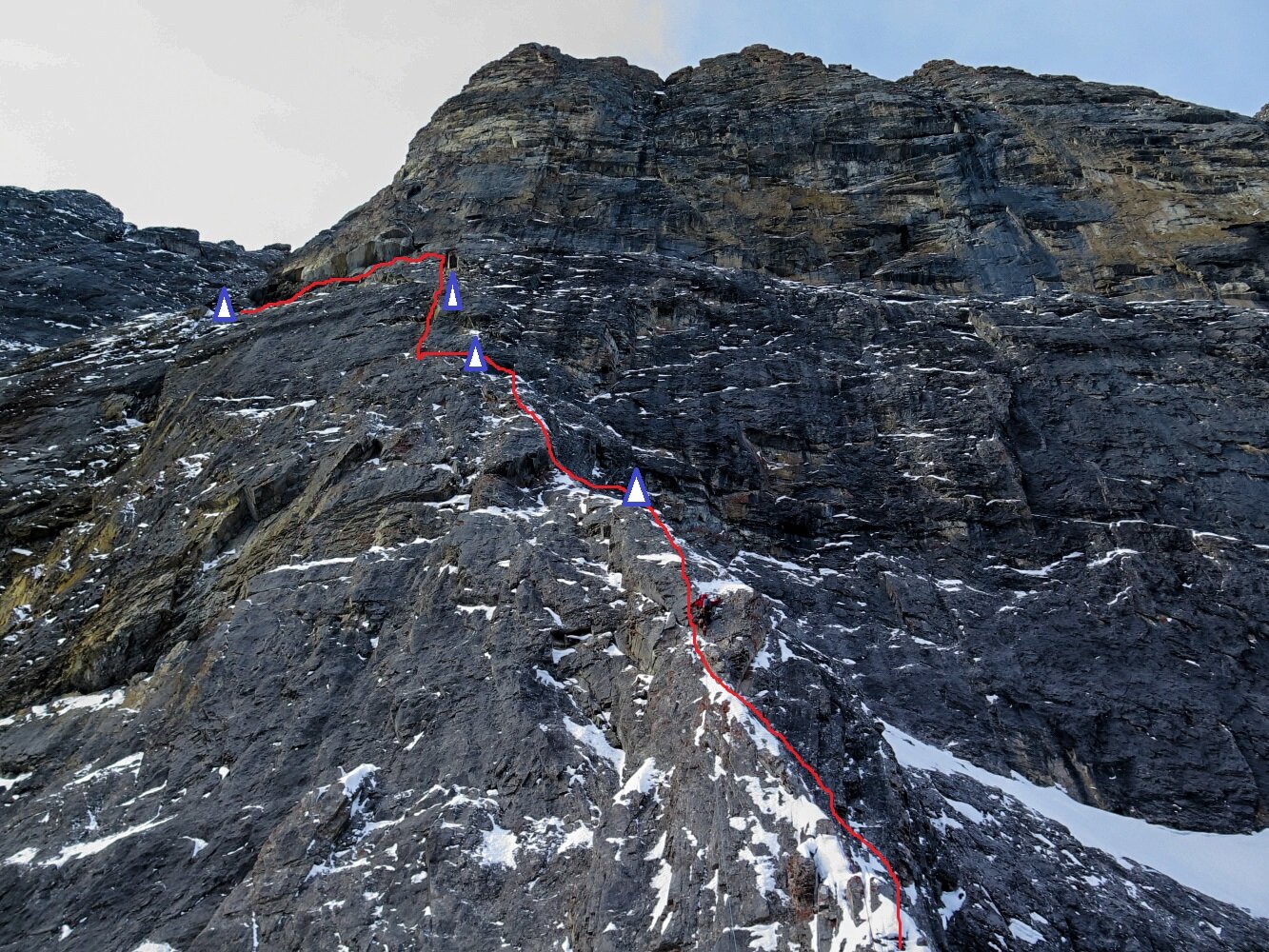I have been thinking recently, after a few drytooling outings, there are only a few who can as confidently face climb in crampons as they would in rock shoes. Required skill for this pitch above Canmore.
Perpetual Spring, 350 meters, M7, Canmore Wall
FA Feb. 18, 2015
Alik Berg, Raphael Slawinski, Ian Welsted
Approach as for Kurihara. http://www.tabvar.org/node/149
In the winter with avalanche hazard we found it best to stick to the trees between the two main gullies draining the Canmore Wall. Approx. 2 to 2 1/2 hours uphill from the start of the trail at the south/east end of the Peaks of Grassi section of Canmore. Gain the Highline trail. Head up the first drainage you get to on this trail, then head right into the treed ridge. There is essentially zero avalanche hazard on the approach, on route, or from above.
At the base of the face traverse left around the butress climbed by the first pitch of Kurihara. A gully system heads up behind the tower which is climbed by the first 2 pitches of Kurihara. There are only short steps of rock which lead to a hanging upper bowl of snow.
http://www.tabvar.org/sites/default/files/Kurihara_Topo.pdf
Pitch 1. 45 meters. Climb a very short rock step into a narrow low angled gully. The length and difficulty of this step will vary according to snow conditions. It is possible the rock will be completely covered by snow. Amble up the easy gully to make a pin belay just below the steep step on the left of the gully. One fixed pin low on the left in the snow, 2 other pin placements possible upon careful examination.
Pitch 2. 60 meters. . Climb the bulge on the left on positive hooks with no pro, M5. After only 5 meters angle relents and gear exists. Exit easily into the upper bowl. Amble up the bowl to the ridgetop.
Pitch 3. 55 meters. This is the 3rd, easy pitch of Kurihara, except climb the natural line just right of the arete rather than clipping the bolts on the left. We used the bolted anchor slightly right of the natural line.
Pitch 4. 40 meters. Leave the line of Kurihara. Step left back onto the short steep arete, M4. Top out after 10 meters onto a low angled slope which becomes a nice ledge after heading left below a steep solid wall. Belay before the corner around to the left. This will shelter the belay from the next crux pitch.
Pitch 5. 40 meters, M7. Step down and left into the very obvious left facing corner for easy climbing for the first 20 meters. Harder climbing at a small lateral roof, continue up cracks above. Step right onto the arete so as to shelter the belay. 2 fixed pins. Extra finger to hand sized cams useful.
Pitch 6. 30 meters, M6. Continue up the corner until it is possible to traverse left on thin holds heading toward the large obvious roof running left. Belay on pins (one fixed) at the first ledge 7-8 meters left of corner. It is possible that an alternative to this pitch would be to head left at 5 meters off the belay to a left-leaning roof crack weakness.
Pitch 7. 40 meters, M5. Head straight sideways left. Make a committing but easy downclimb for a body length down from the overhang in a corner feature at 10 meters. Continue on an easy foot ledge toward the sharp arete with snow visible beyond. Belay at the arete, at the start of the easy snow slope.
Pitch 8. 60 meters. Easy snow slope with a few steps of ice (!!) and a short steep section. Belay below an obvious narrow snow-choked chimney.
Pitch 9. 60 meters, M4 Climb the narrow chimney and another easier narrow chimney higher and stretch the ropes out in the easier upper gully.
Pitch 10. 60 meters. Finish off with easy ground until in the upper scree bowl. Continue to the ridge and more solid rock.
Descent: amble up to the peak of the wall. Locate a gully climber's left of the very summit. This is the area of the Kurihara top-out. There is a single bolt on a slab 8 meters back from the edge. Walk 5 meters to climber's left of the top-out, and find a two bolt anchor on the front side of a solid block of rock 3 feet down on the front side (likely to be covered by snow). Rappel Kurihara.
Rack: We took a rack of 10 knifeblades, some angles, two peckers and a few Lost Arrows and did not find it excessive. A set of wires and a single rack of cams to blue C4 with doubles in finger to hand sizes is adequate. A couple of stubbies are useful in the upper gully.
Stem up easily past the inviting crack and into the hanging bowl.
From here the routeline is fairly obvious, on the left buttress before the long traverse left under the big roof.
On our second go we brought in the ultimate Rockies ringer, Raphael Slawinski. This sideways mantle on non-existent feet had eluded me on the first attempt. One of the weirdest drytooling moves I have seen.
Very few people feel comfortable, in my experience, questing out across thin face edges in crampons. Not sure I could have led this pitch, and not terribly enticing to go back to find out having seconded it. This face traverse was the missing link to bring us to the big roof.
Alik was clearly enjoying himself trundling blocks that could have been heard on the main street of Canmore.
The hydro pond (so popular in the summer with SUPers) gives the location away.
By the upper corner, the route is basically in the bag.


















